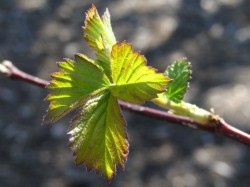
In the rose family, the genus Rubus includes cultivated red, golden, purple and black rapsberries as well as blackberries. Homeowners and landscapers alike can be confused about pruning these berries.
Consider growing these plants on a wire trellis system to promote good air flow and facilitate training.
Blackberries grow long arching canes that are often very lengthy and thorny. The fruit is borne on canes that are more than one year old. However, the most productive canes are not older than three years. In March, remove the oldest canes at ground level, in favor of the younger ones. Cut back any lateral brances to six or eight inches. Head back canes to 6″ above the top wire. In summer, tip back new growth to 6″ above the top wire to encourage lateral fruiting branches.
Raspberries produce upright canes that are generally shorter than blackberries. Most types of raspberries are summer-fruiting. The fruit is borne on canes that have overwintered from the previous season. These second-year canes will flower, fruit and then die back to the ground. In March, remove any dead, damaged or spindly canes at ground level.
Some raspberries are fall-fruiting. These types produce canes that will flower and fruit at the top part of the cane in the first growing season. Over the winter they will die back somewhat, but will then flower and fruit on the lower cane portion in summer. After this second fruiting, the entire cane will die. The best way to maintain these types is to mow all canes to ground level in March. This will produce a single crop in the fall.
